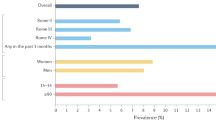Abstract
Faecal incontinence occurs in up to 10% of community dwelling persons ≥65 years of age and approximately 50% of nursing home residents. It is a vastly under-reported problem that has a devastating effect on those who experience it as well as their spouses and caregivers.
There are three broad categories of faecal incontinence among the elderly: (i) overflow incontinence; (ii) reservoir incontinence; and (iii) rectosphincteric incontinence. The first two can be diagnosed based upon the patient’s history and physical examination and the response to dietary and pharmacological interventions. The third is assessed by careful physical examination supplemented by diagnostic tests directed towards evaluation of anorectal continence mechanisms. The most important of these is anorectal manometry, which can be supplemented by studies of structure (anal ultrasonography or pelvic floor magnetic resonance imaging) and neuromuscular function (electromyogram). A variety of therapeutic interventions are employed in patients with rectosphincteric incontinence; these include dietary, behavioural, pharmacological and surgical modalities chosen on the basis of the results of diagnostic testing. For isolated internal anal sphincter weakness, a cotton barrier in the anal canal is often effective. Acute sphincter injury is best treated with sphincteroplasty but, otherwise, surgical procedures are of uncertain benefit. Peripheral neurogenic incontinence may be treated with antidiarrhoeal agents, biofeedback techniques and dietary manipulations. Sacral spinal nerve stimulation is a promising new technique for selected patients with neurogenic faecal incontinence and is currently undergoing testing in the US and Europe. Significant improvement in quality of life can be achieved in most elderly persons with faecal incontinence.








Similar content being viewed by others
Notes
The use of trade names is for product identification purposes only and does not imply endorsement.
References
Whitehead WE, Wald A, Norton NJ. Treatment options for fecal incontinence. Dis Colon Rectum 2001; 44: 131–42
Johanson JF, Lafferty J. Epidemiology of fecal incontinence: the silent affliction. Am J Gastroenterol 1996; 91: 33–6
Nelson RL. Epidemiology of fecal incontinence. Gastroenterology 2004; 126: S3–7
Chassagne P, Landrin I, Neveu C, et al. Fecal incontinence in the institutionalized elderly: incidence, risk factors and progrnosis. Am J Med 1999; 106: 185–90
Harari D, Coshall C, Rudd A, et al. New onset incontinence after stroke: prevalence, natural history, risk factors and impact. Stroke 2003; 34: 144–50
Nelson R, Furner S, Jesudason V. Fecal incontinence in Wisconsin nursing homes: prevalence and associations. Dis Colon Rectum 1998; 41: 1226–9
Wagner TH, Hu T-W. Economic costs of urinary incontinence in 1995. Urology 1998; 51: 355–61
Chiang L, Ouslander J, Schnelle JF, et al. Dually incontinence nursing home residents: clinical characteristics and treatment differences. J Am Geriatr Soc 2000; 48: 673–6
Tariq SH, Morley JE, Prather CM. Fecal incontinence in the elderly patient. Am J Med 2003; 115: 217–27
Bharucha AE. Fecal incontinence. Gastroenterology 2003; 124: 1672–85
Palmer KR, Corbett CL, Holdsworth CD. Double-blind crossover study comparing loperamide, codeine and diphenoxylate in the treatment of chronic diarrhea. Gastroenterology 1980; 79(6): 1272–5
Diamant NE, Kamm MA, Wald A, et al. AGA technical review on anorectal testing techniques. Gastroenterology 1999; 116: 732–60
Whitehead WE, Schuster MM. Anorectal physiology and pathophysiology. Am J Gastroenterology 1987; 82: 487–97
Norton C, Kamm MA. Anal plug for faecal incontinence. Colorectal Dis 2001; 3: 323–7
Cheung O, Wald A. Review article: the management of pelvic floor disorders. Aliment Pharmacol Ther 2004; 19: 481–5
Read M, Read NW, Barber DC, et al. Effects of loperamide on anal sphincter function in fecal incontinence and urgency. Dig Dis Sci 1982; 27: 807–14
Hallgren T, Fasth S, Delbro DS, et al. Loperamide improves anal sphincter function and continence after restorative proctocolectomy. Dig Dis Sci 1994; 39: 2612–8
Heymen S, Jones KR, Ringel Y, et al. Biofeedback treatment for fecal incontinence: a critical review. Dis Colon Rectum 2001; 44: 728–36
Wald A. Biofeedback for fecal incontinence. Gastroenterology 2003; 125: 1533–5
Norton C, Chelvanayregam S, Wilson-Barnett J, et al. Randomized controlled trial of biofeedback for fecal incontinence. Gastroenterology 2003; 125: 1320–9
Pettit P, Thompson JR, Chen AH. Sacral neuromodulation: new applications in the treatment of female pelvic floor dysfunction. Curr Opin Obstet Gynecol 2002; 14: 521–5
Ganio E, Masin A, Ratto C, et al. Short-term sacral nerve stimulation for functional anorectal and urinary disturbances: results in 40 patients: evaluation of a new option for anorectal functional disorders. Dis Colon Rectum 2001; 44: 1261–7
Madoff RD. Surgical treatment options for fecal incontinence. Gastroenterology 2004; 126: 2004; 126: S48-54
Karoui S, Leroi AM, Koning E, et al. Results of sphincteroplasty in 86 patients with anal incontinence. Dis Colon Rectum 2000; 43(6): 813–20
Halverson AL, Hull TL. Long-term outcome of overlapping anal sphincter repair. Dis Colon Rectum 2002; 45(3): 345–8
Malouf AJ, Chambers MG, Kamm MA. Clinical and economic evaluation of surgical treatments for faecal incontinence. Br J Surg 2001; 88(8): 1029–36
O’Keefe EA, Talley NJ, Zinsmeister AR, et al. Bowel disorders impair functional status and quality of life in the elderly: a population based study. J Gerontol A Biol Sci Med Sci 1995; 50: M184–9
Acknowledgements
The author wishes to thank Helen Gibson for her expert preparation of the manuscript.
No sources of funding were used to assist in the preparation of this review. The author has no conflicts of interest that are directly relevant to the content of this review.
Author information
Authors and Affiliations
Corresponding author
Rights and permissions
About this article
Cite this article
Wald, A. Faecal Incontinence in the Elderly. Drugs Aging 22, 131–139 (2005). https://doi.org/10.2165/00002512-200522020-00004
Published:
Issue Date:
DOI: https://doi.org/10.2165/00002512-200522020-00004




